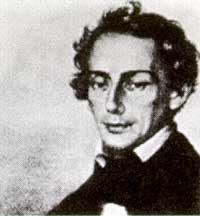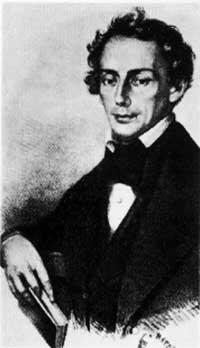Doppler, Christian
1995/08/02 Azkune Mendia, Iñaki - Elhuyar Fundazioa | Kaltzada, Pili - Elhuyar Zientziaren Komunikazioa
(1803-1853)
This Austrian physicist was born in Salzburg on 29 November 1803. He studied at the Polytechnic Institute in Vienna. In 1835, not getting a place at the University, he made plans for emigration to the United States, but at the last moment he began to work as a professor at the Polytechnic School of Prague and abandoned the idea of going to America. Years later, he worked as a professor at the University of Vienna.

In 1842 he discovered the acoustic effect (Doppler effect) that bears his name. The Doppler effect says that when the wave source moves with the observer, the sound also changes from sharp sound to low sound. The best known example is the txistu of the locomotive. When a person is in the station and passes the train, it is noticed that he passes from the sharp sound to the low sound.
Doppler explained this phenomenon as: when the source of sound waves is approaching the observer, the frequency of the wave it receives will be lower, making the sound more demanding, and when this source is removed, the wave frequency that the observer receives will be higher, making the sound lower.
In 1842 he obtained a mathematical relationship that related the tone to the relative movement of the wave source and the observer. Stone trials were conducted two years later in the Netherlands. During these two days, a locomotive dragged a car back and forth at different speeds. Inside the car there were several turbid ones that played different notes. On Earth, musicians with great skill to note the tone wrote notes drawn from those murky when the train approached and walked away. From there came the Doppler equation.
Doppler announced a similar effect with light waves, although its explanation was not entirely correct. Years later, the French physicist Fizeau rehearsed this theory and became an important part of astronomy. This effect causes the light of the stars and galaxies arriving on Earth to move red if they move away and approach blue. The Doppler effect, apart from astronomy, is used in radars and modern navigation.
Doppler died on 17 March 1853 in Venice, Italy.

Gai honi buruzko eduki gehiago
Elhuyarrek garatutako teknologia




